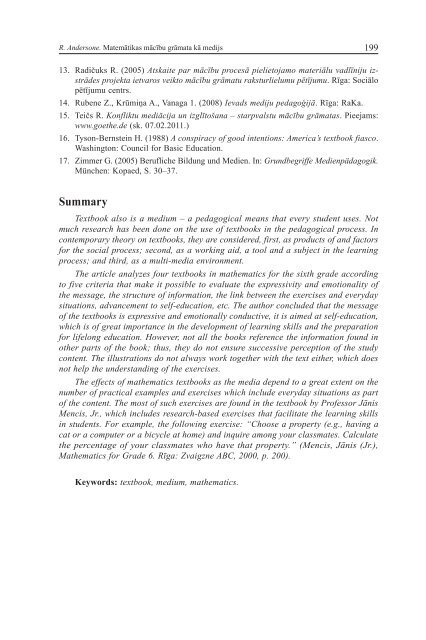You also want an ePaper? Increase the reach of your titles
YUMPU automatically turns print PDFs into web optimized ePapers that Google loves.
R. Andersone. Matemātikas mācību grāmata kā medijs 199<br />
13. Radičuks R. (2005) Atskaite par mācību procesā pielietojamo materiālu vadlīniju izstrādes<br />
projekta ietvaros veikto mācību grāmatu raksturlielumu pētījumu. Rīga: Sociālo<br />
pētījumu centrs.<br />
14. Rubene Z., Krūmiņa A., Vanaga <strong>1.</strong> (2008) Ievads mediju pedagoģijā. Rīga: RaKa.<br />
15. Teičs R. Konfliktu mediācija un izglītošana – starpvalstu mācību grāmatas. Pieejams:<br />
www.goethe.de (sk. 07.02.201<strong>1.</strong>)<br />
16. Tyson-Bernstein H. (1988) A conspiracy of good intentions: America’s textbook fiasco.<br />
Washington: Council for Basic Education.<br />
17. Zimmer g. (2005) Berufliche Bildung und Medien. In: Grundbegriffe Medienpädagogik.<br />
München: Kopaed, S. 30–37.<br />
Summary<br />
Textbook also is a medium – a pedagogical means that every student uses. Not<br />
much research has been done on the use of textbooks in the pedagogical process. In<br />
contemporary theory on textbooks, they are considered, first, as products of and factors<br />
for the social process; second, as a working aid, a tool and a subject in the learning<br />
process; and third, as a multi-media environment.<br />
The article analyzes four textbooks in mathematics for the sixth grade according<br />
to five criteria that make it possible to evaluate the expressivity and emotionality of<br />
the message, the structure of information, the link between the exercises and everyday<br />
situations, advancement to self-education, etc. The author concluded that the message<br />
of the textbooks is expressive and emotionally conductive, it is aimed at self-education,<br />
which is of great importance in the development of learning skills and the preparation<br />
for lifelong education. However, not all the books reference the information found in<br />
other parts of the book; thus, they do not ensure successive perception of the study<br />
content. The illustrations do not always work together with the text either, which does<br />
not help the understanding of the exercises.<br />
The effects of mathematics textbooks as the media depend to a great extent on the<br />
number of practical examples and exercises which include everyday situations as part<br />
of the content. The most of such exercises are found in the textbook by Professor Jānis<br />
Mencis, Jr., which includes research-based exercises that facilitate the learning skills<br />
in students. For example, the following exercise: “Choose a property (e.g., having a<br />
cat or a computer or a bicycle at home) and inquire among your classmates. Calculate<br />
the percentage of your classmates who have that property.” (Mencis, Jānis (Jr.),<br />
Mathematics for Grade 6. Rīga: Zvaigzne ABC, 2000, p. 200).<br />
Keywords: textbook, medium, mathematics.

















